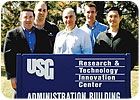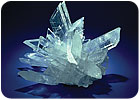.jpg)

I met Kevin Moyer at the national plastering contest held last year in Long Beach, Calif. I listened as he spoke of the future of the plastering industry and the need for skilled plasterers to meet the expected demand of a trade once in decline, but now on the eve of a renaissance. I asked him then if I could have the opportunity to interview him for Walls and Ceilings and recently our schedules permitted us to get together. Kevin invited me to visit him in Chicago and tour both the New Business Ventures Group located in the west loop of Chicago and the USG Research & Technology Innovation Center, located in Libertyville, Ill.
On my taxi ride over to Kevin’s office, I could not help but recall those rides in my dad’s pickup truck, that little red and white handbook, and my introduction to the trade. I thought quietly to myself as we drove through the streets of Chicago that I was now walking into what must surely be the “holy grail” of the plastering industry. After nearly 50 years of the industry seeing the plaster business steadily decline, USG believes that because of its durability, beauty, fire resistance, acoustics and almost limitless range of application and design potential; lath and plaster offers exceptional value and growth potential for their company. The following is Part I of my tour of the USG facility and a personal interview with Kevin Moyer, Business Manager, Superior Walls Finishes for USG.

KM: I am an engineer by training and began my career with USG as a Project Engineer in a roll form steel plant, where we manufactured steel studs, beads and trims. One of my fi rst assignments was to decommission the old B-1 Bridge Clip line that was used for connecting Rocklath Brand plaster base. I was also in research for about 10 years before moving into the marketing division. I’ve worked on promoting both wallboard and plaster products and was part of the team that brought the Decorative Interior Finish System (DIFS) product to market.
WR: What is USG’s view on the role of interior plaster in today’s competitive construction market?
KM: In the heyday of plastering, we manufactured products at a dozen different locations. As the product market share declined over time, we continued to manufacture products at all of those original plants, but in lesser amounts. We decided to consolidate the manufacturing of plaster products into four locations: Boston; Shoals, Ind.; Gypsum, Ohio and Empire, Nev. This consolidation allowed us to invest and modernize our processing methods and rebrand our products. This is when we began packaging in 50-pound bags instead of the 100-pound and 80-pound bags everyone was used to for so many years.
WR: Where were you when I was 19 and throwing around those 100-pounds bags of hardwall?
KM: The feedback on packaging into smaller bags has been very positive overall. Occasionally we will get a contractor who might make an order that doesn’t factor the smaller bags into account, and his crew will call up and say they are short, but generally the transition has been well accepted. The packaging also now has a consistent look across our entire plaster product line and we have incorporated bilingual and in some cases tri-lingual instructions. The bilingual would include English and Spanish and the tri-lingual labeling would add French. USG has invested a significant amount of money in our plastering products and we feel we are now positioned for growth.
WR: Won’t a growth in plaster diminish your drywall sales?
KM: We are not in competition with drywall. We have performed several focus groups and one thing that came through loud and clear is that today people don’t think they have choices about their wall finish system because they are not being offered anything other than drywall. We see this as an area for potential growth … on very high-end residential 90 percent of owners polled would upgrade to a plaster system, two-thirds of those said they would select a two-coat veneer system. One knock on the wall tells it all, however there is a price point that must be met to make it affordable to homeowners if the product is to be marketable. We need to be able to provide productivity and quality. The industry needs to pay decent wages and expect productivity. The question is: “Can we deliver a quality system the consumer will be willing to pay more for and where everyone in the chain can make money?” What we like about you guys in the unions is, you get it! You have a system of apprenticeship training and you recognize the connection between training and productivity. This isn’t about killing people to get the job done; it’s about working smart, planning your day, planning out your work. One thing we are looking at is certifi cation. How do we manage how the plaster is put on the wall? When it’s done right there is nothing like it, when it’s done wrong it is hideous. And there is a big variation between someone who has had training-such as in your apprenticeship programs-and someone who is just picking up a hawk and trowel for the fi rst time… I am passionate to do whatever I can to see this renaissance occur, and truly believe there is a place for plaster. For those contractors who do quality work there will be more work for them in the future.
WR: Is the future of our business about refi ning existing products or developing new ones?
KM: That is what we call incremental development versus revolutionary development. The answer is, it’s both. We are looking at what we can do to extend the product lines we have now to keep them relevant, and we are looking down the road three to fi ve years to develop things no one else has done before. We base a lot on what contractors tell us; we take that input and break it down to technical development to try and meet those needs. Then we go through an entire product development cycle, all the way from prototyping to fieldtesting to fi nally full-blown release and commercialization. The trick, quite frankly, is that the contractor or the applicator is not going to tell you, “if you do this or that to the material it’ll work better or you’ll sell more of it.” It’s subtler than that. Usually it’s in observation of the application process and listening to comments in the fi eld, innocuous comments that might not mean a lot to them at the time might be huge in terms of how we refi ne or develop a product. Recognizing this opportunity, we try and stay close toour customer, our contractors.

I will continue my interview with Kevin Moyer in my next column, when we can further explore the wonders of the inner sanctum of the USG Research Facility and expand on what USG has up its sleeve to help rebuild a market for its plastering product line. For further information on USG and the versatile rock and building material called “Gypsum,” please refer to these online resources: • USG website:www.usg.com. • National Museum of Natural History, Smithsonian Institute, Department of Mineral Sciences: www.minerals.si.edu. • United States Geological Survey: http://minerals.usgs.gov/minerals/pubs/commodity/gypsum.




Report Abusive Comment